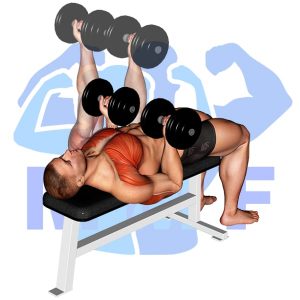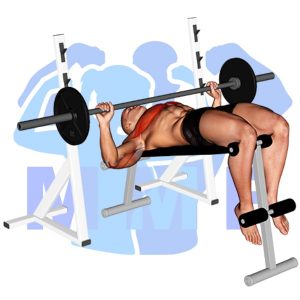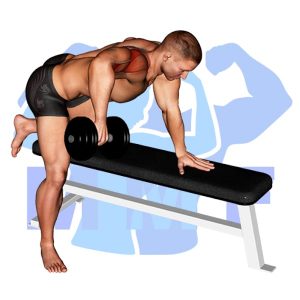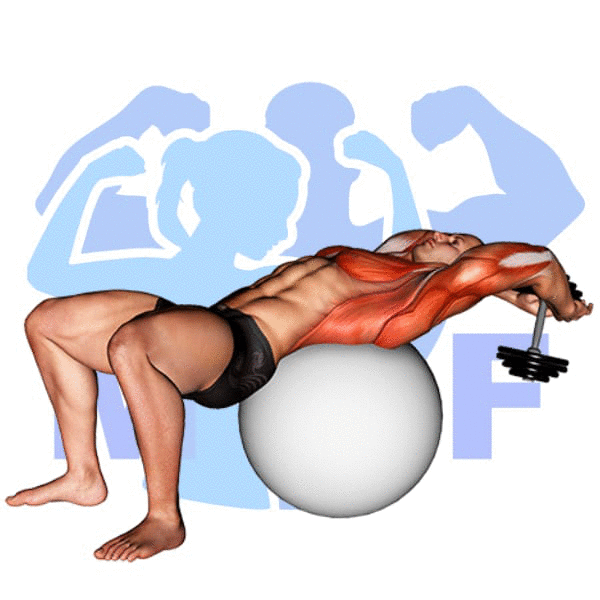Have you ever struggled with chest exercises, specifically the lever decline chest press? Don’t worry, you’re not alone. It’s a common issue among fitness enthusiasts who are trying to target their lower chest. A big reason for this problem is that the lower chest muscles are often weaker than the upper chest muscles, making them harder to engage. But fear not, there is a solution to this problem. In this blog post, we’ll explore the lever decline chest press and how it can help you build a stronger and more defined lower chest.
Lever Decline Chest Press (Machine) Summary
- Primary Muscles: Pectoralis Major – Sternal
- Secondary Muscles: Pectoralis Major – Clavicular, Deltoid – Anterior, Triceps Brachii
- Equipment: Decline Chest Press Machine
- Mechanics Type: Compound
- Force: Push
- Utility: Basic or Auxiliary

Lever Decline Chest Press (Machine) Instructions
- Lie on a flat bench with a dumbbell in each hand.
- Plant your feet firmly on the floor.
- Pull your shoulder blades together and lift the dumbbells off the floor.
- Bring the dumbbells up to chest level with your arms straight and palms facing away from your body.
- Slowly lower the weights towards your chest, keeping your arms close to your body and elbows slightly bent.
- Push the weights back up to the starting position.
- Repeat for desired number of repetitions.
Video Tutorial
Lever Decline Chest Press (Machine) Muscles
Target (Agonist)
- Pectoralis Major – Sternal
Synergists
- Deltoid – Anterior
- Pectoralis Major – Clavicular
- Triceps Brachii
- Wrist Flexor
Dynamic Stabilizers
- Biceps Brachii – Short Head
Stabilizers
- Pectoralis Minor
- Serratus Anterior
Antagonist Stabilizers
- None

Benefits of Lever Decline Chest Press (Machine)
The Lever Decline Chest Press (Machine) is an excellent exercise to add to any strength training or fitness routine as it specifically targets the Pectoralis Major – Sternal muscle. This exercise helps to strengthen the chest and upper body, improve posture and balance, and increase stability and coordination. The Lever Decline Chest Press (Machine) specifically works the Pectoralis Major – Sternal muscle in a way that few other exercises can, allowing for a greater range of motion and a more complete workout. It can also help to increase muscular endurance and promote better overall muscular development. As an added benefit, this exercise can also help to reduce lower back pain as it promotes good posture and balanced musculature.
Tips for Performing Lever Decline Chest Press (Machine)
The Lever Decline Chest Press is a great way to tone and strengthen your chest, shoulders, and arms. With proper form, this exercise can be a great addition to your fitness routine. To get the most out of this exercise and see the results you want, it’s important to remember a few key tips.
- Maintain proper form: To maximize the benefits of the Lever Decline Chest Press, it is important to maintain proper form throughout the exercise. This means keeping your back flat on the bench, engaging your core muscles and chest, and ensuring that your arms are fully extended as you press the weight.
- Use a slow and controlled movement: Make sure to perform the exercise with a slow and controlled movement, in order to work the targeted muscles more effectively. This will also help to reduce the risk of injury.
- Increase the weight gradually: As your strength increases, it is important to gradually increase the weight that you are using in order to keep challenging your muscles. This will help ensure that you continue to see results from the exercise.
Benefits and Tips Video
Frequent Mistakes To Avoid
When it comes to the Lever Decline Chest Press, it is important to perform the exercise correctly in order to get the most out of it and avoid potential injury. To ensure that you are getting the most out of the exercise, be sure to avoid the common mistakes that many people make. Below is a list of the most frequent mistakes made when doing this exercise.
- Not engaging your core muscles: Performing the Lever Decline Chest Press with proper form requires engaging your core muscles to help stabilize your body. Failing to do this can cause your form to suffer, leading to ineffective and potentially dangerous exercise execution.
- Moving too quickly: Moving too quickly when performing the Lever Decline Chest Press can cause you to use momentum instead of muscle power, resulting in an ineffective workout. It is important to focus on a slow and controlled movement when performing this exercise.
- Locking out your elbows: Locking out your elbows at the top of the movement can put unnecessary strain on your shoulders and elbows, increasing the risk of injury. Instead, keep a slight bend in your elbows as you press up to ensure proper form and minimize the risk of injury.
Find More Machine Exercises Here
Variations and Complementary Exercises
When looking for alternative exercises to the Lever Decline Chest Press (Machine), it is important to look for exercises that work similar muscle groups. This will ensure that you still get the same benefits from the exercise while also adding variation and helping to reduce the risk of repetitive strain injuries. Here are some variations, complementary, or alternative exercises that you can use:
Lever Incline Chest Press (Machine)

The Lever Incline Chest Press (Machine) is a great complement to the Lever Decline Chest Press (Machine) exercise. It works similar muscles, but with a different angle. This exercise focuses on the upper chest and shoulder muscles, allowing for greater range of motion and more effective targeting of those muscles. It also helps to improve posture and build overall strength. It is a great alternative exercise for those who are looking to target the same muscle group, but with a different angle.
Dumbbell Reverse Grip Bench Press

The Dumbbell Reverse Grip Bench Press is a great complement or alternative to the Lever Decline Chest Press. This exercise is performed with the palms of your hands facing up and your elbows tucked in close to the body. It works the same muscles as the Lever Decline Chest Press, but with an emphasis on the upper chest and triceps. The reverse grip allows for greater range of motion, and you can also move the dumbbells in opposite directions to further challenge yourself. This exercise also helps to reduce strain on the shoulder joint, making it a great choice for those who experience shoulder pain when doing traditional chest presses.
Barbell Bench Press

The Barbell Bench Press is a great complementary exercise to the Lever Decline Chest Press (Machine). While the Lever Decline Chest Press focuses on the chest muscles, the Barbell Bench Press works on the entire upper body, including the chest, shoulders, arms, and triceps. It also allows for greater range of motion and utilizes more muscle fibers than the Lever Decline Chest Press. The Barbell Bench Press also gives you more control over the speed and intensity of the exercise, allowing you to adjust the weight and resistance as needed. This makes it an excellent alternative to the Lever Decline Chest Press for those looking to increase their strength and muscle mass.
Check Out These Top Machine Exercises
Barbell Decline Wide Grip Press

The Barbell Decline Wide Grip Press is a great complementary or alternative exercise to the Lever Decline Chest Press. This exercise requires the use of a barbell and allows you to work the chest muscles from a different angle than the machine-based Lever Decline Chest Press. By working the muscles from a different angle, you can further target and strengthen the chest muscles, leading to improved strength and muscle growth. Additionally, this exercise also works the triceps and shoulders, making it a great full-body exercise.
Barbell Wide Bench Press

The Barbell Wide Bench Press is an effective exercise to target the same muscles as the Lever Decline Chest Press (Machine). This exercise is performed by lying on a flat bench with the feet firmly planted on the ground. The barbell is held in both hands and pushed up from the chest until the arms are fully extended. The barbell should be held wider than shoulder width apart to maximize the range of motion and work the chest muscles more effectively. It is a great complement to the Lever Decline Chest Press (Machine), as it allows for additional variety and stimulation of the chest muscles.
Cable Chest Press

The Cable Chest Press is a great alternative or complementary exercise to the Lever Decline Chest Press machine. It uses a cable machine and allows for greater range of motion than the machine-based exercise. Unlike the Lever Decline Chest Press, which focuses on the lower chest, the Cable Chest Press targets both the upper and lower chest muscles. Additionally, this exercise offers the ability to use different grip angles and widths to target different muscles, making it more versatile than its machine counterpart. The Cable Chest Press also allows for more control over the load applied, making it an ideal exercise for beginners and experienced lifters alike.
Find More Chest Exercises Here
Opposing Complementary Exercises
In order to fully target the chest muscles and enhance the effectiveness of the Lever Decline Chest Press (Machine), it is important to supplement it with exercises that work opposing muscle groups. Working opposing muscle groups helps to create balance in your chest muscles, which can prevent any potential injuries while increasing strength. The following exercises are recommended as a complement to the Lever Decline Chest Press (Machine):
Barbell Skier

Barbell Skier is an excellent exercise to pair with the Lever Decline Chest Press (Machine) in order to achieve a full-body workout. Barbell Skier targets the back and shoulder muscles, while the Lever Decline Chest Press (Machine) focuses on the chest and arms. By combining these two exercises, you can effectively work both the opposing muscle groups at the same time, allowing for a complete and balanced workout. Furthermore, Barbell Skier’s dynamic nature increases core stability and balance, as well as promoting flexibility and coordination. This makes it the perfect complement to the Lever Decline Chest Press (Machine), which requires a more static posture.
Dumbbell Bent Over Row

The Dumbbell Bent Over Row is a great complementary exercise to the Lever Decline Chest Press (Machine). It works the opposing muscle group of the chest, namely the back. This exercise helps to develop strength and stability in the upper back and posterior shoulders, while also building mass in the lats and mid-back. It helps to create a balanced physique by engaging the opposing muscle groups of the chest. In addition, it can help to improve posture and reduce risk of back injuries by strengthening the muscles along the spine. Overall, this exercise is a great way to ensure that your chest and back muscles are working together in harmony.
Dumbbell One Arm Row

The Dumbbell One Arm Row is an effective exercise that works the muscles in your back, and it is complementary to the Lever Decline Chest Press (Machine). This exercise targets the opposing muscle group of your chest, making it a great complement to the Lever Decline Chest Press. By doing both exercises, you can ensure that you are working both your chest and your back muscles in equal measure. The Dumbbell One Arm Row is an effective exercise for building strength, improving posture, and increasing muscular endurance.
Transform Your Chest with the Lever Decline Chest Press!
If you’re looking to add some serious definition and strength to your chest, the lever decline chest press might just be the exercise you’ve been searching for. This challenging movement targets the lower portion of your pecs, helping to add bulk and shape to your chest muscles. By using a lever machine, you can perform the exercise with perfect form and take your chest training to the next level. Add the lever decline chest press to your routine and watch your chest transform before your very eyes!
References: Wikipedia | ExRx.net | PubMed.gov | Comprehensive List of Chest Machine Exercises




